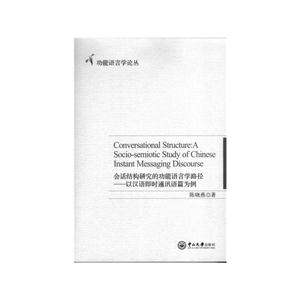会话结构研究的功能语言学路径-以汉语即时通讯语篇为例
本书特色
[
电子语篇的出现,改变了人们构建人际意义的方式,也为语言学研究带来了新的课题。本书以qq、msn、阿里旺旺等汉语即时通讯为例,探讨了电子语篇和电子会话的性质和定义,以系统功能语言学的会话结构理论为框架,讨论电子会话语篇的功能和路径,以及在实现方式和使用频率方面的特征。本书从功能语言学的角度对电子语篇进行了阐述,为电子会话研究提供了一种新的视角,对人们认识、了解相关研究提供了一定的指导与借鉴。
]
作者简介
[
陈晓燕,女,中山大学/澳大利亚麦考瑞大学博士,华南师范大学外国语言文化学院讲师,研究兴趣包括功能语言学、语篇分析、语料库语言学、英汉对比研究等。
]
目录
acknowledgements前言abstractlist of figureslist of tableslist of abbreviationsexchange slotsglosses in the english translation of chinese textschapter 1 introduction 1.1 aimsand objectives 1.2 the internet: a brief history 1.3 from cmc to imdiscourse: a preliminary delimitation 1 4 cmc: from socio-psychol0gical perspectives 1.4.1 the cues-filtered-out vision 1.4.2 the cues-filtered-in vision 1.5 structure of the bookchapter 2 a linguistic view of electronic discourse 2.1 introduction 2.2 e-discourse: nature and taxonomy 2.2.1 nature of e-discourse 2.2.2 taxonomy of e-discourse 2.3 e-discourse: a multi-level linguistic profile 2.3.1 graphological and lexico-grammatical patterns 2.3.2 discourse organizational patterns 2.4 e-discourse: a social-cultural and multilingual perspective 2.4.1 the english internet 2.4.2 the multilingual internet 2.5 summarychapter 3 toward a systemic functional model of conversation 3.1 introduction 3.2 an overview of relevant approaches 3.2.1 conversation analysis 3.2.2 the birmingham school 3.2.3 speech act theory 3.3 language as social semiotic 3.3.1 language as system 3.3.2 language as strata 3.3.3 language as functions 3.4 conversational structure 3.4.1 the exchange structure system 3.4.2 the speech function system 3.4.3 the mood system 3.5 data and methodology 3.6 summarychapter 4 describing instant messaging discourse 4.1 introduction 4.2 defining im discourse: a “mode” description 4.2.1 mode revisited 4.2.2 e-discourse: the third discourse type? 4.2.3 the mode of im discourse 4.3 units of analysis in im discourse 4.3.1 identifying discourse units in oral conversation 4.3.2 message and turn in im discourse 4.3.3 move and move complex in im discourse 4.4 summarychapter 5 conversational structure as encoding of mode 5.1 introduction 5.2 exchange structure: classes and proceeding 5.2.1 exchange structure classes 5.2.2 interleaved exchange proceeding 5.3 speech function: classes and realizations 5.3.1 the mood type system in chinese 5.3.2 syfioptic speech functions 5.3.3 dynamic speech functions 5.4 summarychapter 6 conversational structure as encoding of tenor 6.1 introduction 6.2 tenor revisited 6.2.1 dimensions of tenor 6.2.2 linguistic manifestations of tenor dimensions 6.3 relationships in the workplace: peers and supervisor-supervisee 6.3.1 general discourse features 6.3.2 features at the exchange rank 6.3.3 features at the move rank 6.4 relationship in the family: parent-child 6.5 relationship in online service encounters: vendor-customer 6.6 summarychapter 7 conclusions 7.1 introducuon 7.2 a summarizing overview 7.3 implications and limitations 7.4 suggestions for future research 7.5 concluding remarksreferencesappendicesappendix 1: sample interfaces of the three im programsappendix 2: away messages of the three im programsappendix 3: typical preprogrammed emoticons of the three im programsappendix 4: typical online shopping procedures on taobao.comappendix 5: english translation of text 1: yamu & starappendix 6: english translation of text 2: umber & ecloudappendix 7: english translation of text 3: chunyan & noon88appendix 8: english translation of text 4: lark & rosemaskappendix 9: english translation of text 5: jill & kittyappendix 10: english translation of table 4.3appendix 11: english translation of table 5.4
封面

书名:会话结构研究的功能语言学路径-以汉语即时通讯语篇为例
作者:陈晓燕
页数:341
定价:¥38.0
出版社:中山大学出版社
出版日期:2015-09-01
ISBN:9787306052872
PDF电子书大小:72MB 高清扫描完整版
